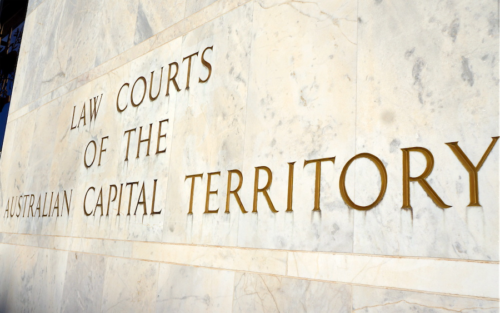
The City Renewal Authority’s new report portrays a mono-culture of mainly white faces whereas the city is composed of people from many cultural backgrounds. It makes no serious effort to identify the senior members of the community and their requirements. The emphasis seems to be on people no older than the Chief Minister, writes Canberra Matters columnist PAUL COSTIGAN.

The ACT government’s pet pop-up project, the City Renewal Authority (CRA), is two years old and to mark the anniversary it released on Friday (July 5) yet another colourfully threatening document, this time to tell the world how it is to do something to the suburban areas from the lake north to Dickson.
Residents have been surprised by the simplistic and disingenuous terminology used to describe the parts of the city from the lakeside to the Dickson shops as one, single, urban precinct. There were no consultations on this. Although the dangers to the cherished nature of the bush capital are obvious.
Locals are referring to this latest bureaucratic wonder as the CRA Precinct Program (CRAPP). Besides the chair of the North Canberra Community Council, resident groups were not invited to the “CRAPP” launch nor knew anything about it till its presence oozed out.
On page 6 of the CRAPP document, there is this statement: Encouraging the end users of a development to be involved from project inception through to project delivery can foster community and instil within those users a sense of ownership and responsibility for how it not only works but also supports community wellbeing.
The reality is that residents were not invited and the signs are that resident participation will not be necessary. The CRAPP is here and no debate is required.
Images used within the document portray a mono-culture of mainly white faces whereas the city is composed of people from many cultural backgrounds. The paper makes no serious effort to identify the senior members of the community and their requirements. The emphasis seems to be on people no older than the Chief Minister.
The CRAPP document introduces four quotes as value statements.
Quote One from Ministry for the Environment, NZ: Good urban design can offer significant benefits to the community; conversely, poor design can have significant adverse effects on the urban environment, society and economy.
Quote Two is from Jan Gehl: First life, then spaces, then buildings: the other way around never works.
Three is An Urban Design Protocol for Australian Cities: High quality urban design becomes even more important as we increase the density of our cities and cater for a growing and changing population.
Four is a quote from Oscar Niemeyer: In architecture it isn’t enough to just have the right building that works well. It can also be beautiful. It can also be different. It can create surprise. And surprise is the main thing in a work of art.
These four quotes serve no purpose except to make someone feel good. The reality is that nothing in the present DAs for developments indicates any addressing of Urban Design principles – they are not required under the present planning codes.
Dickson residents have argued for the Dickson Parklands (Section 72) to be upgraded to cope with new community, social, arts facilities as the number of residents increase; such an approach would be fundamental to good urban design. Requests are ignored by local politicians, their agencies and the bureaucrats.
The city is witnessing very ordinary international-style buildings with loads of cladding, glass and steel and heaps of apartment towers, there is very little human scale and no recognition of the city’s bush capital’s heritage or aesthetic.
The CRAPP does not deal with the developments and apartment towers planned for Northbourne alongside Downer and Watson. This is a curiosity given that these areas will be the first part of the gateway to the city.
There is a use of statistics throughout the CRAPP document. Yet a quick check of the ABS data for Dickson reveals different statistics and far more useful information. Which one should we believe?
There are far too many urban-speak statements that mean very little. Take for instance this useless statement that states the obvious as if something new was to happen:
The opportunity is at hand to transform Dickson as an urban centre, offering a “complete” lifestyle with housing choice, retail, business and employment opportunities serviced by rapid transit. It will retain its strong community focus and unique sense of identity built around its Asian and other dining, hospitality and local service activities.
That is a very basic outsider’s description of Dickson – with nothing new. Then there is this urban speak: New development will contribute a greater mix of uses while expanding its fine-grain elements.
Does anyone know what “fine-grain elements” means?
West Basin remains one of the listed CRAPP targets with this important lakeside area to be replaced with more heat islands and trendy, boring apartments. If the use of the quotes above was serious, then the NCA and the ACT government would be working with residents on enhancing these parklands for future enjoyment and to maintain the aesthetic and heritage aspects of Lake Burley Griffin.
The CRAPP report on pages 89 and 90 contains heaps of “doing words”, being words report writers use when they are trying to cover up that not much is happening beyond basic planning, having meetings, advocacy, prioritising, improving, and things they might do… along with things other agencies are doing.
The reaction to date has been one of more frustrations with this government and this pop-up agency.
Residents don’t ask for much. The list includes good landscape design, greenery, trees, social, community and arts facilities along with human-size architecture that addresses the significant changes to the climate.
The CRAPP does not provide any confidence that these aspirations are being addressed. The fear is that the CRAPP document signals that the approach is to play games with urban speak and provide easy short-term distractions while the nation’s bush capital is eroded through inadequate planning and ad hoc and inappropriate developments.
This CRAPP is not good for this city. Canberra residents are looking for intelligence, creativity and a humanity in our leaders and their agencies. We are left still waiting.
Who can be trusted?
In a world of spin and confusion, there’s never been a more important time to support independent journalism in Canberra.
If you trust our work online and want to enforce the power of independent voices, I invite you to make a small contribution.
Every dollar of support is invested back into our journalism to help keep citynews.com.au strong and free.
Thank you,
Ian Meikle, editor




Leave a Reply